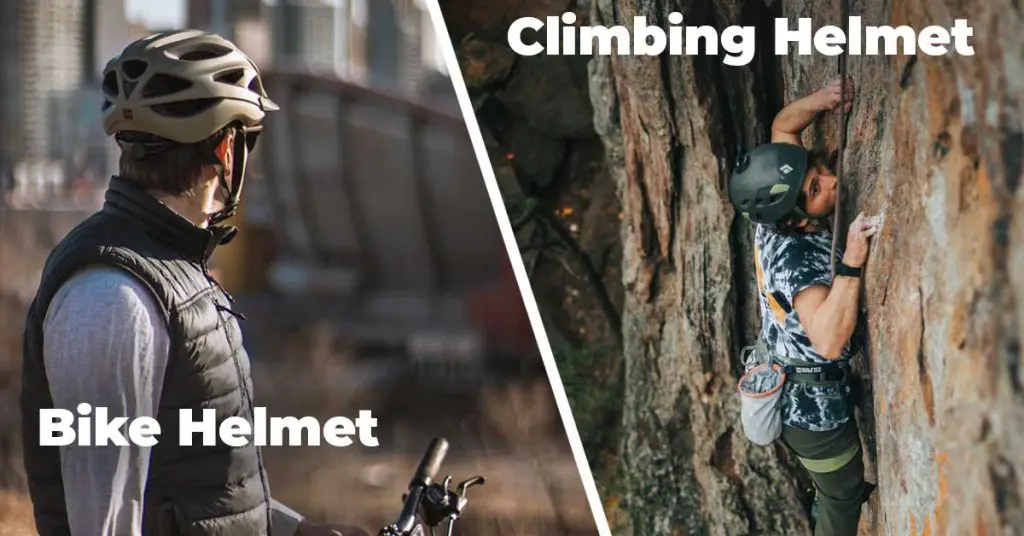Climbing Helmet - Can I Wear My Bike Helmet for Climbing?
You may have heard of bike helmets and wonder if they will protect you while climbing. While they are designed for single impact, they are more lightweight, offer more ventilation, and use smart technologies such as MIPS. Each type of helmet offers different benefits, so you should consider the price, protection, and comfort when making a decision.
Bike Helmet – Designed for an Single Ground Impact
When comparing bike helmets and climbing helmets, look for the EN standard. This standard is based on a series of tests, including impacts from 1.5 meters, a flat anvil, and a curbstone. The helmets are also tested for temperature, UV light, and aging. The EN standard is considered to be the most rigorous safety testing for bike helmets.
Most helmets are made of EPS or EPP foam, which is similar to the foam found in Styrofoam coolers and packaging peanuts. But the density of EPS is more durable, which makes the material more resistant. However, EPS can only withstand a single hard impact before its energy transmitting properties break down. This means that a climbing helmet should be designed with a softer material, since EPS does not absorb impact as well as a harder one.
In addition to their weight, cycling helmets are more aerodynamic than climbing helmets. However, they still provide less protection than climbing helmets. As a result, they are still better than nothing. Unlike the climbing helmets, cycling helmets are designed to prevent a single high-speed impact. Therefore, they are better at protecting you against multiple low-impact collisions.
Bike Helmets vs Climbing
The biggest difference between bicycle helmets and climbing helms--and the reasons why you should wear one--is the type of head protection. Climbing, on the other hand, requires a helmet designed specifically for that purpose. This means that your climbing helmet will be much more comfortable, and likely have adjustable straps for adjusting its fit on the go. Bike helmets are generally lightweight and made of plastic or hard shells, whereas climbing helmets are typically made from a lightweight foam shell. Climbing helmets will also typically have headlamp clips, which are essential if you plan on spending many hours on the rock.
Climbing helmets and bike headgear must meet different standards to protect the head. A cycling helmet must not transfer more than 10kN of force, while a climbing helmet must resist at least tenkN of force. These standards vary widely between countries, but both are generally very stringent, resulting in greater protection. Bike helmets have higher standards, and can be found in various sizes to fit all head shapes.
Bike Helmets – CPSC and EN 1078
When buying a cycling helmet, look for one that meets the standards set by the Consumer Product Safety Commission (CPSC). A bike helmet must withstand a force of at least 3kN. Climbing helmets must withstand up to ten times that force. There are two major standards for cycling helmets: EN 12492 for cycling and UIAA 106 for climbing.
The CPSC standard for bicycle helmets was derived from many non-mandatory safety standards, and is the current minimum standard for all bicycle helmets in the U.S. The CPSC standard is slightly stricter than EN 1078, but both standards provide adequate protection for most users. The CPSC test involves more energy smashes and is more rigorous than EN 1078. To find out if a bike helmet meets the CPSC standards, visit the CPSC website.
The EN standard applies to bicycle helmets, skateboards, and roller skates. It includes impact tests from a 1.5-meter curb and an anvil. Other tests include UV exposure, temperature, and aging. EN helmets must pass the EN1078 test before being marketed. Further, the EN standard meets the standards set by CPSC and the European Standards Committee for Standardization.
EN 1078 in Detail
The safety of cycling and climbing helmets differs greatly. In cycling, for example, the helmet must not transfer more than 3kN of force, whereas in climbing, the helmet must prevent the head from being crushed. Cycling helmets use the EN 1078 standard, while climbing helmets are tested using UIAA 106. The difference between the two standards is outlined below. This article will examine the safety features of each type of helmet to help you decide which type of headgear is right for you.
An EN-certified helmet is tested to be impact resistant. Its quality is determined by a series of tests, including impacts from a 1.5 m curb and a flat anvil. It is also tested for temperature, UV rays, and aging, which is slightly less rigorous than the US standard. It is still recommended to purchase a bike helmet over a climbing helmet, especially if you have very active outdoor pursuits.
Climbing helmet – EN 12492 & UIAA 106
The European Union has created safety standards for climbing helmets. The EN standard tests the helmets for impact strength and durability from impacts at 1.5m, and they are also tested for UV, temperature, and aging. The European standards are slightly less stringent than the US ones. If you are worried about safety in your job, you should purchase a helmet that meets the EN standards.
Climbing helmets typically contain an EPS disc in the crown area. EPS foam helps absorb impacts from falling objects. Most composite helmets have a hard plastic outer shell, but you can get climbing helmets made of flexible, durable EPP foam. Some of these helmets are composite, with the outer shell being made of ABS or polycarbonate. The Vision and Sirocco helmets contain an EPS disc in the crown area.
The most popular brand of climbing helmets is Petzl, which has a new patented protocol that provides better protection than other brands. Petzl has a range of helmets that meet the UIAA 106 standard. If you are not sure which one to buy, check the reviews online and see which ones people have used. You will find the perfect helmet that fits you!
EN 12492 in Detail
The difference between a climbing helmet and a bicycle helmet lies in how they are tested. In contrast, cycling helmets are tested with a strike mass of 5 kg and three impacts at 60 degrees. Climbing helmets are tested by hitting a flat, hemispherical strike mass, a stationary flat striker from 50cm, and a vertical, rounded-off striker.
A climbing helmet protects the head from the side, front, and rear impacts of falling rocks. A bike helmet, on the other hand, can get damaged or crumpled, and it will not protect the head fully in case of a collision. This makes a cycling helmet an inferior choice for climbing. The difference between a climbing helmet and a bike helmet is significant and can be confusing for non-experts.
When choosing a climbing helmet, look for a certified one. There are many certified climbing helmets out there, but a cycling helmet does not. Mountaineering helmets are designed to be lighter and offer better ventilation. While bike helmets are less durable than climbing helmets, mountaineering helmets are still better for some situations. A bike helmet may not be as comfortable, so be sure to check the ventilation before making a decision.
Short Comparison of the Two Standards
Currently, there are two major standards in place for climbing and cycling helmets. These standards require that the helmets be shaped like a head and be able to transmit an impact force of up to five kilograms to the head. The impact forces are tested by using 3 different impacts at 60 degrees and a hemispherical strike mass, as well as a flat striker at 50 cm.
In general, weight and durability are inversely related: the lighter the gear, the less durable it is. However, there are two main types of foam used in climbing helmets: EPP foam, which absorbs impact, and EPS foam, which fractures to handle blunt force. EPS designs have ABS hard shells, which are more durable than polycarbonate.
While bicycle helmets are lighter and more comfortable than climbing helmets, they are also not ideal for rock climbing. A helmet made for mountain biking and cycling does not have the same ventilation openings as a climbing helmet does. Furthermore, a bicycle helmet will not protect you from falling rocks. As a result, the two standards are not compatible. To find out if your climbing helmet meets these standards, read the individual helmet standards for each category.
Conclusion
There's no doubt that a climbing helmet can save your life. Petzl has collected stories of climbers whose lives would have been in danger without a helmet. There are also photos of busted helmets, which suggest that these climbers would not be alive today if they hadn't worn a helmet. Climbing helmets also prevent concussions. Here's what you need to know to decide which helmet is right for you.
A cycling helmet's impact-retention system must be strong enough to resist the force of a fall, whereas a climbing helmet must resist up to 10kN of force. Climbing helmets are tested to comply with two standards, which differ slightly from each other. The European standard EN 12492 is a little less strict than the Snell standard, and both are tested to withstand impacts at 60 degrees.
While head injuries from cycling are uncommon in rock climbing, they can be serious, especially if you fall. It's important to remember that head injuries from climbing are very rare, but they're also catastrophic. To prevent these injuries, you need to wear a helmet that offers full coverage and provides good ventilation. A bicycle helmet is not designed for rock climbing, but it is ideal for biking and can also protect your neck and head.


Comments
Post a Comment